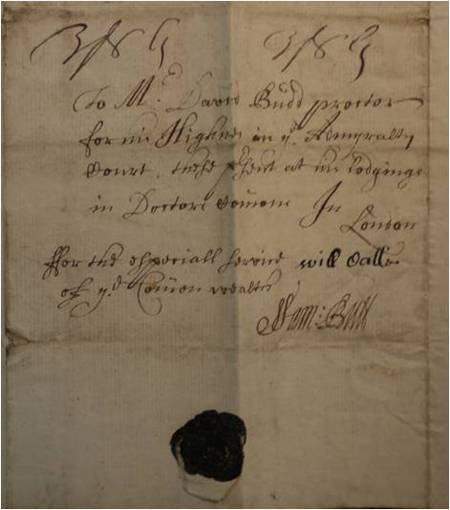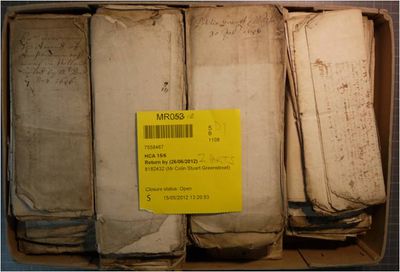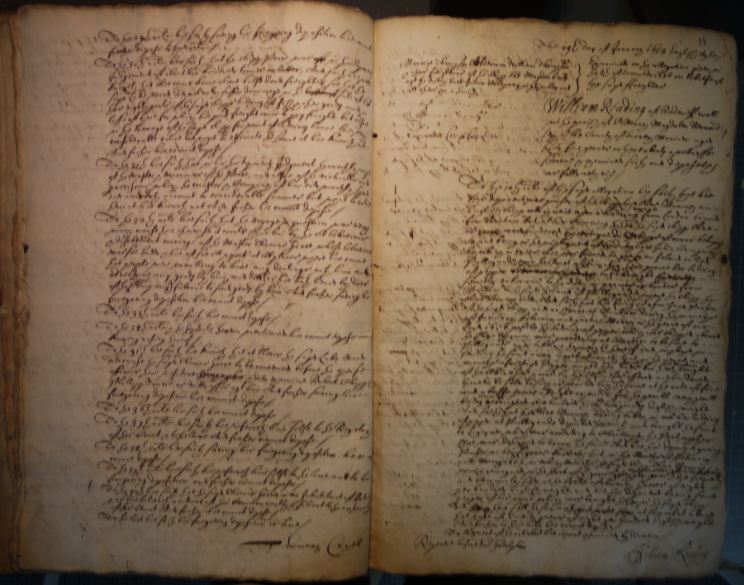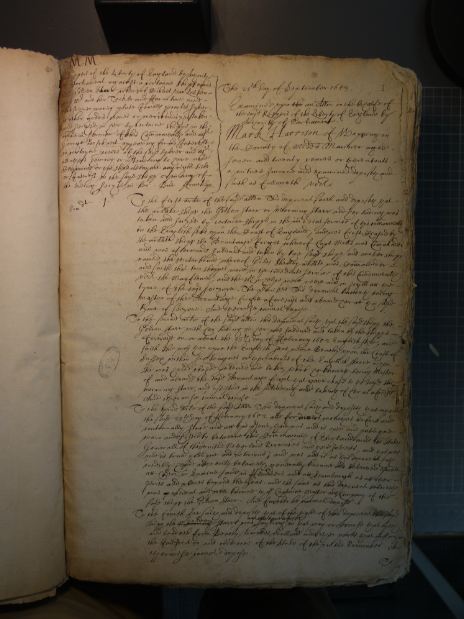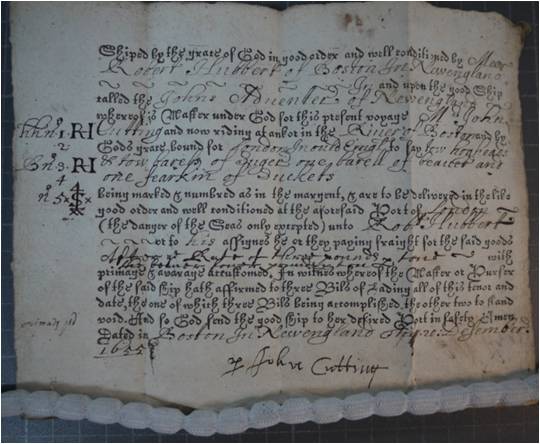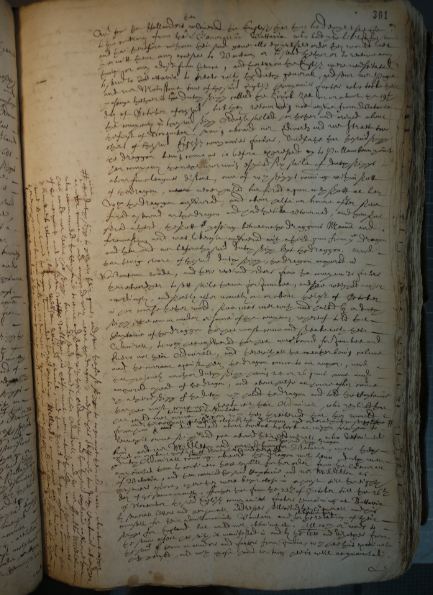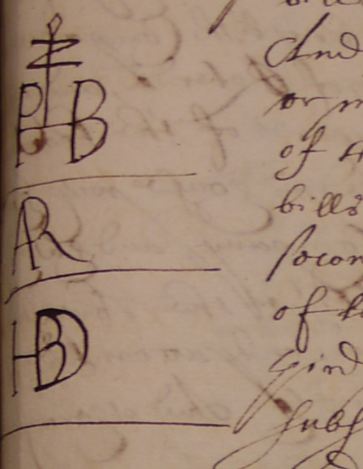Introduction to the High Court of Admiralty
Introduction to the High Court of Admiralty
Editorial history
11/08/12: CSG, created page
Purpose of this page
To provide an introduction to the C17th High Court of Admiralty in London
Contents
- 1 What was the High Court of Admiralty?
- 2 What do the records of the Admiralty Court look like?
- 3 Types of records
- 4 Language and procedures
- 5 Tracing stories through the Admiralty Court records
- 6 What records of the Admiralty Court are at the National Archives?
- 7 Sample transcriptions, 1650-1669
- 8 Historiography
- 9 Suggested reading
What was the High Court of Admiralty?
- When was the Court established?
- The High Court of Admiralty was established in the 1320 to deal primarily with questions of piracy or spoil
- What was its jurisdiction?
- Over time its jurisdiction developed to cover prize and civil jurisdiction in such matters as salvage and collision
- Actions could be taken against ships and goods as well as against persons
- After the restoration (of the monarchy) in 1660, the civil business of the court divided, with an instance court and a prize court
- Who were the judges?
- The judges were doctors of civil law, who had studied at either Oxford or Cambridge
- Their legal training differed from that of lawyers practising the common law, who were admitted to Inns of Court in Holborn
- The judges of the High Court of Admiralty held court sessions at Doctors Commons, which before the London fire of 1666 was located in the parish of St Paul Bennetts wharf
Text extract: Obligation compelling George Walters to appear at Doctors Commons before the Judges of the High Court of Admiralty, March 2nd, 1656
"The Condition of This Obligacon is such That If the
Above bounden George Walters shall be and Appeare before
The Lord Protector of The Commonwealth of England x:r
the Judges of the high Court of Admyralty of England
At the Commons hall wthin y:e Doctors Commons Scituate in
The parish of Sainct Benedict neare Pauls Wharfe London
The Tenth day After the date hereof if it be Court day
or Else The next Court followinge At The usuall houres
for hearinge of Causes, To Answer unto Thomas Skinner
in A Cause Civill & Marine, And shall not departe from
-thence, without Leave, And Licence of the Court That
Then this obligacon to be void & of non Effect
Otherwayes to stand in full force power & vertue"[1]
- Several other types of legal official and lawyer attended the sessions of the High Court of Admiralty. These included proctors, public notaries, clerks, and legal counsel for the parties concerned
Illustration: Document wrapper addressed to M:r David Budd, proctor for his Highnes in y:e Admyralty Court, HCA 15/6 Box Two, ca. 1658
- Who were the protagonists in legal disputes?
Plaintiffs: XXXX
Defendants: XXXX
Witnesses: XXXX
Legal counsel: XXXX
What do the records of the Admiralty Court look like?
Leather bindings
- Most of the HCA record series consist of paper manuscript pages, which have been collated into volumes and been stitched into large leather bindings. Pages are usually, but not always, in chronological order. Presumably errors in chronology occured during the collation process. Most of the bindings from the period 1650-1669 are original.
Illustration: Front leather cover of bound volume, HCA 13/68, 1653/54
- The record series HCA 15/6 is an exception, and consists of loose, boxed documents. A greater variety of handwriting is to be found in these documents, since many are the products of non-legal hands, and since the document types are very diverse. They include bills of lading, bonds, charter parties, financial accounts of voyages, inventories, letters, and petitions.
Illustration: HCA 15/6, second of two boxes of loose documents
Double page spreads
- Typical volumes have text on both sides of paper pages
- Folio numbers (if available) are to be found on the top right hand side of the right hand page. These right hand pages are described as "recto"
- Left hand pages do not bear folio numbers, and are described as "verso"
- Folio numbers may have been written by the court clerk at the time of collating the individual sheets into the bound leather volume, in which case they will be in ink. Or they may have been added at a later stage, also in ink, or in block printing. If block printed, they will have been added by an archivist. Occasionally there is a discrepancy of one or more sequential numbers between the original foliation and subsequent archival foliation. If so, you should note the two different folio numbers on your transcription, making clear which is in ink and which is block printed
Illustration: Open volume showing left and right hand pages, HCA 13/73 f. 14v & f. 15r
Typical single leaf layout
First page in volume, HCA 13/68 f. 1r
- Text covers the bulk of the page, but with discernible blocks
- Margin available on left (of both recto and verso pages) for additional notes
- Case summary details top left
- Date of the court session (here it was the 22nd of September 1659, but written as
The 22:th day of September 1659
- Modern block printed folio number in top right hand corner (here it is folio one, and should be described when transcribing as f. 1r (folio one recto; recto = right, or front)
- Brief statement as to nature of the legal record (here it is an examination)
Examined upon an Allon on the behalfe of
the sayd Keepers of the Liberty of the Liberty of England by
Authority of Parliament
- Witness name, place of abode, and estimated age at top of main text
Mark Harrison of Wapping in
the County of Midds Mariner aged
seven and twenty yeares or thereabouts
a witnes sworne and examined deposeth and
saith as followeth. vizt
- Abbreviation in left hand margin "Ren:dt" (contraction for latin word, XXX = XXX)
- Number in left hand margin stating which number witness in the specific legal case (here this is the first witness)
- Main body of text (here consisting of thirty seven lines, divided into four paragraphs)
- Paragraphs in main body of text introduced with the phrase "To the first(second/third/fourth) arle of the sayd allon this deponent saith and deposeth that..."
- First word of next page at bottom right hand side of page, below end of main text
Page part: Summary case details
Illustration: Clayme of Domingo Centurione, HCA 13/68 f.305v
Page part: Fuller case details
Illustration: Parliament vs. the Golden Starr, HCA 13/68 f.1r
Page part: Page bottom
Illustration: XXXX, HCA 13/68 f.164v
Handwriting
Very clear italic hand
Illustration: XXXX
See [Transcription]
Very clear formal italic hand
Illustration: XXXX
See Transcription
Flowing italic hand
Illustration: XXXX
See [Transcription]
Mixed printed text and non-legal hand
Illustration: Bill of lading, dated Dec. 20th, 1655, HCA 15/6 Box Two, no folio no.
See Transcription
Marginalia
Text marginalia: Block of text
Illustration: Block of text at 90 degrees in LH margin of RH page, HCA 13/73 f. 301r: XXXX
- Short phrases are often found in the margin of depositions
- Occasionally, larger blocks of text can appear in the margin of HCA documents
- Here there is a block of text with XX lines at a ninety degree angle to the main text
Text marginalia: Abbreviation
Illustration: Text abbreviation in LH margin at start of an examination on an allegation, Xth March 1658/59, HCA 13/73 f. 52r
Merchants marks
Example: Merchants Marks in LH margin, HCA 13/68 f. 304r
To see the whole page in high definition from which the extract below is taken, [download here]
- Can you make out the letters in the Merchants marks?
- Several of them combine or overlap letters to produce stylised initials
- Merchants marks are frequently found on bills of lading, and HCA documents often refer to specific types and quantities of goods laden on ships, "as marked in the margent"
- The merchants marks are from a deposition by XXX made on XXXX. They refer to the merchants XXXX, XXXX, and XXXX.
Deletions and interpolations
Line through text
Illustration: From deposition of George Dethwick, merchant of London, aged thirty yeeres or thereabouts, dated Jan. 24th 1658/59, HCA 13/73, no folio no.
- Can you read the words which have been crossed through?
- When transcribing this block of text, you should reproduce the crossed out words, but mark them as crossed out
[ADD EXAMPLE OF INTERPOLATIONS]
Signatures
- Signatures can be wonderfully flamboyant
- A surprising number of common seamen were sufficiently literate to sign their names
Illustration: Signatures of John Shorter, XXXX, and William Warren, HCA 13/129, no folio no., recto
- These three signatures show very different styles
- The signators are John Shorter, XXXX, and William Warren
- Note the unusual "r" at the end of Shorter, which looks rather like an "x"
- Note the shortening of William to W:m
- Note the pronounced flourish on the "J" of John, and the lengthy downward sloping lines on the "m" and "n" of William Warren
- John Shorter and William Warren were both London merchants and known to be in partnership in the timber trade between Norway and other countries in the "Eastlands" and London. The Eastlands was a geographical term used in the mid-C17th to refer to a number of cities, coasts and countries which broadly, but not exactly, match what we now term the Baltic area
- For a useful guide to unfamiliar mid-C17th geographical terms and language when you are transcribing HCA documents, try our online Geographical and Place Term dictionary
Illustration: The marke of Henrick Williamson, HCA XX/XX, XX
- The marke of Henrick Williamson appears between henrick's first and second names
- Markes (or marks) can vary hugely. Some are the first letter of the individual's name. Others are simple drawings, or geometrical shapes. What does Henrick's marke remind you of?
- Henrick Williamson was a XXXXX. He was deposed in the case of XXXX
Punctuation
[ADD EXAMPLES]
Spacing
[ADD EXAMPLES]
Types of records
- Why were records kept?
- Who kept the records?
Allegations
- What is an allegation?
- An example: XXXX
Answers
- What is an answer?
- An example: XXXX
Examinations
- What is an examination?
- An example: XXXX
Interrogatories
- What is an interrogatory?
- An Interrogatory is a pre-prepared list of questions to be put to deponents by the proctors of the High Court of Admiralty
- An interrogatory consists of numbered questions which are primarily English, though often introduced with Latin phrases
- Such interrogatories can be found in bound leather volumes in the HCA 23 record series, for example HCA 23/19 (1658-1664)
Illustration: Loose foldover front leather cover with clasp, HCA 23/19 (1658-1664)
- Example from HCA 23/19
- Example: Introduction & first question from Interrogatories in behalf of John Absolun[2]
"Interrogatoryes on the behalfe of John Absolon
to be administered to whatever prdsed wutnesses
produced or to bee produced on the behalfe of
Nicholas Payne as followeth,
1 Imprimis Interrogot:r quilet testis to what shippe hee belonged
and how hee commeth to be a witnes in this cause whether
hee doth not well know that the Shipp the Swanne of
which the said Absolon was master commeing from New-
castle upon or about the seaventeenth of may last 1660
about 10 or 11 of the clock in the morneing sett saile
from or neare Newcastle with her ladeing of coales
and whether the shippe the Prospous (sic) of Bright Hampton
did not follow next after the Swanne and y:t they turned
about the bill poynt, Whether the Prospous had not
the greater wynd & did becalme the Swanne & whether
the Maste or some other of the Company of the Swanne
did not call out to the company of the Prosperous to
loare (sic) theire top sailes or else they would come
foule of them, & whether some of y:e Prosperous did not
heare & make answeare that they would warrant that
they would bee foule of them or to that effect, or what
did they say, And let each bee asked joyntly sewally
and of each particular,"
Illustration: Text on recto, no text on verso, fastened by tie in top LH corner, HCA 23/19, unfoliated (1658-1664)
Further single question examples from HCA 23/19
"4. Itmm: interr. When had the Claymers or the wittnesse first
Notice that the shippe Nativity was stayed neere ffalmouth..."[3]
"1 Imprimis Interrogot:r quilet testis to what shippe hee belonged
and how hee commeth to be a witnes in this cause..."[4]
Schedules
- What is a schedule?
- Schedules of information are occasionally referred to in individual answers or in individual examinations
- These schedules are only rarely included in the volume which contains the answers or examinations, despite reference to the documents being "annexed"
- Occasionally, schedules can be found in boxes of loose documents (usually unfoliated), such as HCA 15/6 Box One 1654-1657, and HCA 15/6 Box Two 1654-1657
Illustration: Schedule, HCA 13/128, no folio, recto, 1657
- This schedule is from HCA/129, a volume which covers 1658 to 1662
- The HCA/129 series is one of a number of volumes for the 1650-1669 period which are described as answers to bills of complaint (HCA/123 - HCA/130)
- The schedule lists XXXXX
Language and procedures
- English, with a little latin
- What latin will you find, and how can you read it?
Common Latin Phrases
- English legal and commercial language
Legal Terms
Tracing stories through the Admiralty Court records
- As you and your team start to transcribe consecutive pages, narratives will emerge, of individuals and of families; of ships' companies and of ships themselves
- These narratives may emerge within a single page, or over a series of pages within one answer or examination.
- But a good number will emerge only after a large number of sequential answers or examinations have been transcribed, often with chronological gaps and interspersed with answers or examinations on completely different cases. In many cases this was probably due to the lack of availability of all witnesses on a particular day or consecutive days, due to seamen and mariners being overseas
- One example of a larger narrative to emerge from transcriptions done at the preparatory stage of the MarineLives project is that of Daniel Skinner the elder and his sons. Daniel Skinner the elder was a Dover merchant, as were two of his sons. A further son, Albertus Skinner, was a London merchant.
- If you would like to read more about Daniel Skinner, take a look at the Daniel Skinner case study. This case study synthesises a complex narrative from multiple depositions. Indeed there are probably more relevant depositions in the volume, but time has precluded surveying the entire volume. In the case study you can look at the unedited transcriptions of these depositions. The volume in question is HCA 13/69, and is for the year 1654
- This case study provides a good example of what can be done to link and enrich a transcription.
- The relevant Admiralty Court claim is the "clayme of Daniel Skinner the Elder, Daniel Skinner the younger & Thomas Skinner"
- Two depositions have been taken as the starting point to link and enrich the transcription - the deposition of John Ashurst the younger, of St Andrew Undershaft, merchant, and the deposition of Albertus Skinner, S:t George Buttolphe Lane, merchant.
- Online and offline primary and secondary sources have been used to dig deep into the identities of the individuals and places mentioned, and to look at family and commercial connections
- Manuscript sources have included wills, and Chancery Court records
- Online printed sources have included calendars of Treasury books, of State Papers, of the East India Company, and of the House of Lords and House of Commons journals. They have also included online books of printed primary sources, such as parish registers, and online printed editions of C17th letters, such as the correspondence of Samuel Pepys
- These sources have been accessed physically at the National Archives, Kew, and online via the National Archives Discovery tool, British History Online, Internet Archive, and Google Book
- But all this is icing on the cake. Our starting point on the Marine Lives project is to become familiar with the High Court of Admiralty records and to produce a top quality, accurate, consistent transcription of the words on the page. This will be our focus in training at our kickoff session on August 20th 2012, and for our week of facilitator supported training in the week of September 3rd 2012. It will also be our focus for at least the first eight weeks of the project, as we proceed through September and October and become more comfortable with our transcription skills, and each facilitator supported team begins to develop a corpus of transcribed material
What records of the Admiralty Court are at the National Archives?
- What records are in Kew?
- The National Archives at Kew contains the extensive records of the High Court of Admiralty from as early as 1536 until 1859
- An index of the mid-C17th High Court of Admiralty record series has been prepared for the project team. See TNA index, 1650-1669
- How did they get there?
- How can you see them?
- The records of the High Court of Admiralty can be viewed in the Large Manuscripts and Maps Room on the second floor of the National Archives at Kew
- You will need a reader's ticket, which can be obtained on the day of your visit. You will need to take two valid pieces of identification with you - one with a recent photograph of you, and the other with your home address and of a recent date. See Obtaining a Reader's ticket
- HCA manuscripts can be ordered at any terminal in the Large Manuscripts and Maps Room, and may take between thirty and sixty minutes to be produced from storage
- The National Archives are closed on Sundays and Mondays, but are open Tuesday through Saturday, with late opening on Tuesday and Thursday. See TNA Opening Times
Sample transcriptions, 1650-1669
You can get an overview of the different document series within the HCA classification by looking at Overview of HCA material, 1650-1669
Once you have done some palaeography training, and want to take a look at some whole HCA manuscript pages, you can see a set of digital images of untranscribed pages from the HCA 13/68 volume: HCA 13/68: Sample images: untranscribed
- If you feel ready, or simply inquisitive, why not take a shot at transcribing one of these pages?
- Your team facilitator is there to support you, including helping you with your palaeographical questions, so why not share your questions and your practice work with them, and with your fellow project associates? No one gets it right first time, or even on a second or third attempt. There are always words and phrases which will elude you, but which fresh eyes may be able to help you with them
- You may also want to take a shot at transcribing some other HCA 13/68 manuscript pages for which there is a first cut unedited transcription, and compare your attempt with the first cut unedited version: HCA 13/68: Sample images: draft transcriptions available
- Can you improve on what has been done? Can you fill in blanks, or resolve any queries the earlier transcriber has flagged up? Why don't you add your comments to the bottom of the earlier transcription and discuss similarities and differences with your team facilitator and fellow project associates
Historiography
[DEVELOP THIS SECTION]
Suggested reading
Appleby, John C. (ed.), A Calendar of material relating to Ireland from the High Court of Admiralty Examinations, 1536-1641 (Irish Manuscripts Commission, 1992)
Murphy, Elaine (ed.), A calendar of material relating to Ireland from the High Court of Admiralty, 1641-1660 (Irish Manuscripts Commission, Dublin, 2011)
Senior, W., Doctors Commons and the old court of admiralty (London, 1922)
- Internet Archive online edition
Shilton, Dorothy O. and Richard Holworthy, High Court of Admiralty Examinations, 1637-1638 (London, 1932)
Snell, Steven L., Courts of admiralty and the common law: origins of the American experiment in concurrent jurisdiction (Carolina Academic Press, 2007)
Steckley, George F., 'Collisions, Prohibitions, and the Admiralty Court in Seventeenth-Century London,' Law and History Review, Spring 2003, viewed 10 Nov. 2011
Steckley, George F., 'Instance cases at admiralty in 1657: A court "packed up with sutors"', The Journal of Legal History, vol. 7, issue 1, 1986, pp. 68-83- ↑ HCA 15/6: Item: Bond George Walters, of the Middle Temple, London Esq:r and Thomas Walker of Camberwell, Surrey: Date: March 2nd 1656 (57) no f.
- ↑ HCA 23/19: Document Number: 6: Case: XXXX: Date: XXXX: P1100666 no f., verso
- ↑ HCA 23/19: Document Number: 4: Case: XXXX: Date: XXXX
- ↑ HCA 23/19: Document Number: 6: Case: XXXX: Date: XXXX
